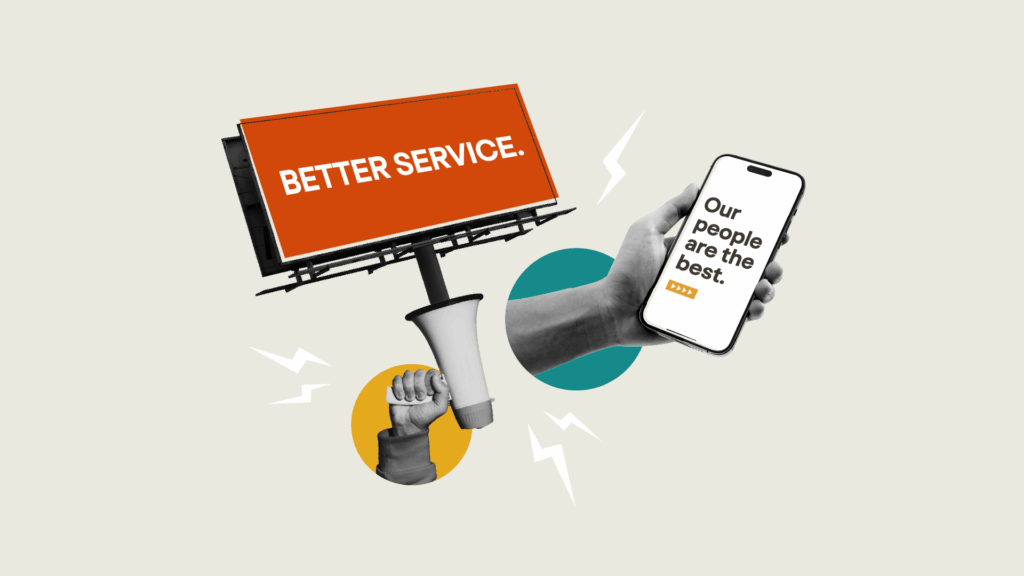Better Service isn’t a Brand—And What to Say Instead

Everyone says it.
Every bank. Every billboard. Every website.
Better service.
Like it’s fresh. Like it’s compelling. Like it’s going to turn heads.
But no one walks into your bank and says,
“I’m here for better service.”
They’re there to open an account. Secure a loan. Solve a problem.
And here’s the truth:
“Better service” isn’t a brand.
It’s not even a differentiator.
It’s the baseline. The status quo.
It’s what customers expect—not what sets you apart.
In a category as crowded and inertial as banking, that’s not just a messaging issue.
It’s a problem that can prevent growth.
The Comfort of the Familiar
“Better service” is easy to say because it feels true.
You know your team works hard. You know customers like you.
So why not lead with that?
Because it’s not a messaging strategy. It’s a safety blanket.
And when your competitors all say the same thing, it loses its meaning.
Drive around town. Look at billboards. Browse a few bank websites.
You’ll see it again and again:
- Where service matters.
- Banking with a personal touch.
- Real people. Real service.
These aren’t differentiators. They’re wallpaper.
The Cost of Vagueness
When everyone says the same thing, no one stands out.
“Better service” becomes background noise. It blends into the landscape.
Worse, it creates a burden of proof you can’t deliver in a slogan or a homepage headline.
It also opens the door to disappointment.
Because what does “better” mean?
To one customer, it’s faster turnaround.
To another, it’s empathy.
To another, it’s not having to come into a branch at all.
If you don’t define it, your audience will.
And they’ll define it against their last bad experience.
When that happens, banks unintentionally set traps for themselves.
They make a promise they haven’t clarified. And when reality doesn’t match the customer’s expectation, trust erodes.
What “Better” Actually Sounds Like
You don’t need to stop offering great service.
You just need to say it differently.
You don’t need to kill the word “better.”
You need to show what your version of better looks like.
Try these reframes:
Instead of: We offer better service.
Say: Your banker answers when you call.
Instead of: We’re here when it matters most.
Say: Open your account in under 10 minutes—online or in-branch.
Instead of: We put you first.
Say: Decisions made in this ZIP code—not at corporate.
Each one replaces a vague aspiration with a vivid reality.
It’s not about being louder. It’s about being clearer.
And it’s this kind of clarity that sets the stage for one of the best recent examples of specificity in service messaging.
The Role of Strategy
Banks don’t default to “service” because it’s bold.
They default to it because it’s familiar, and because they haven’t made a strategic choice about what they want to own.
This means you have to make decisions. You have determine what to actually claim as a benefit.
It means knowing your strength and leaning into it while letting go of the rest.
If your differentiator is responsiveness, prove it.
If it’s relationships, show how those relationships create better outcomes.
If it’s speed, quantify it.
Strategy doesn’t hem you in. It gives you room to move with intention.
Reframing the Message
Think of your messaging as translation.
The customer says: “I’m tired of waiting.”
You say: “Get a loan decision in 48 hours—or less.”
They say: “I feel like a number.”
You say: “You’ll never have to explain your situation twice.”
You’re not describing your team. You’re addressing real friction.
You’re not listing features. You’re reframing the relationship.
And in doing that, you offer something much stronger than “good service.”
You offer relief.
The Real-World Shift: First National Bank of Central Texas
First National Bank of Central Texas (FNBCT) operates in Waco, right in the heart of Texas—a market crowded with good community banks and even better bankers. Word-of-mouth was strong. Their team was respected. Their reputation was solid.
But as they expanded into new markets like Bryan and College Station, reputation wasn’t enough.
People didn’t know them.
And saying “we have great service” wouldn’t cut it in a market where every community bank could say the same.
So we listened.
Their bankers weren’t just friendly or responsive.
They took ownership of the process.
If a loan didn’t go smoothly, they felt it personally.
If a business owner hit a snag, they were the one picking up the phone to clear the path—not pointing to red tape.
This wasn’t service. This was partnership.
The brand line became:
“A bank on your side. A banker by your side.”
It resonated immediately. Not just with leadership. With the bankers themselves.
It wasn’t a clever twist. It was a mirror.
And most importantly, it gave customers something real.
Because banking often feels adversarial—especially for small business owners.
The process can feel like an interrogation:
How do you plan to make money?
Have you thought about this risk?
What if this fails?
This message flipped that dynamic.
Instead of feeling scrutinized, customers could feel supported.
And that subtle shift—from scrutiny to support—is where trust begins.
When Everyone Says They Care
Let’s be honest—every bank says they care about their customers.
But caring is a minimum requirement, not a market position.
The real differentiator is what your care looks like in practice.
Do you simplify?
Do you expedite?
Do you stand beside your customers instead of across the table from them?
If so, show that.
Not through generic declarations—but through tangible promises.
“A banker by your side” is more than a phrase. It’s a structure.
It sets expectations. It defines the relationship.
And that’s what branding is supposed to do.
Final Thought: Let Your Competitors Say “Better”
The next time a competitor rolls out a “where service matters” campaign, take it as a gift.
They’ve just opted out of the race for relevance.
While they’re busy blending in, you’ll be building clarity.
Confidence. Connection.
Customers don’t want platitudes.
They want to know you see their problem—and have a real way to fix it.
“Better service” fades.
But “A banker by your side”?
That sticks.
And a bank on your side too?
That’s not just a message—it’s a mindset.
One that turns vague promises into real expectations.
One that makes people feel something—and remember who made them feel it.
Don’t just say it louder.
Say it smarter.
Say what only you can say.
Then go prove it.



